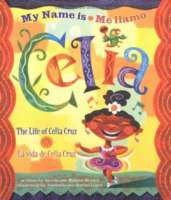
An exuberant picture-book biography of the Cuban-born salsa singer. From its rhythmic opening, the first-person narrative dances readers through Cruz’s youth in Havana, a childhood bounded by scents of nature and home, the sweet taste of sugar, and the sound of music. A singer from an early age, Cruz sang so continually that one of her teachers finally urged her to share her voice with the world. Thus encouraged, she entered competitions, undeterred when her racial heritage prevented her from competing – undeterred, even, when the advent of Castro’s communist regime forced her to leave Cuba as a refugee. Positive even in exile, Cruz made New York City her own and took Miami by storm. The salsa-influenced prose presented in English and in Spanish is followed by a straightforward vita of the singer, noting her death in July 2003. Lopez’s distinguished, luminous acrylic paintings are alive with motion, lush with brilliantly layered colors, and informed with verve and symbolism. This is a brilliant introduction to a significant woman and her music. The only enhancement required is the music itself.
- ISBN: 9780873588720
- Author: Brown, Monica
- Published: 2004 , Luna Rising
- Themes: Musicians, Refugees, Singers
- Descriptors: Bilingual, Biography - Autobiography- Memoir, Caribbean, Cuba, Picture Book, Primary (ages 6-9)
- No. of pages: 32

I really think this is an awesome story for ELL students to feel included, since typically we read to caucasion students. This book is so colorful and alive that students can’t help but like not only this book but this authors other works.
This is probably my favorite in Monica Brown’s series of “My Name Is” books that feature famous Latin American artists. Celia Cruz, the Cuban-born singer who became known as the Queen of Salsa for her singing style,springs to life in the brightly colored illustrations by Rafael Lopez. Lopez, one of the featured artists at the 2011 Tucson Festival of Books, showed the audience some of the artwork he created for this book during his presentation. Lopez works in a very unique way with acrylic paints. He uses very thin pieces of wood for a canvas. He buys bright paints in huge jars, and uses them as background colors, brushing them liberally onto the wooden canvas, then using smaller brushes as well as sharp intruments to create the images. He says the wood gives his paintings a texture that adds to the overall feeling of the work. His illustrations for Celia are particularly apt, as Celia Cruz was certainly a larger-than-life figure. For example, he described how he didn’t want to show Celia leaving her beloved Cuba after her exile in a traditional way; instead, he chose to show her flying to her new country, the US, with her band right beside her and the dark flames of Cuba behind her. The exuberance of his art perfectly capture the brilliance of Celia’s life and music.